This is a list of ten living root bridges which I believe to be especially interesting and worthy of conservation. They are examples of botanical architecture that each say something important and unique about the practice as a whole.
To be included in this list, the bridges had to fit the following criteria:
a): They had to be unusual or record-breaking.
b): They had to be obscure. Root bridges that have been included in major internet or newspaper articles, or about which there is significant information available online (as of May, 2017) were not included.
Inclusion in this list is not necessarily an aesthetic judgment on the root bridges found below. Some of the most interesting bridges I know of are not especially photogenic, and some of the most photogenic are not in good condition.
Bridges are listed in alphabetical order.
BURMA 1
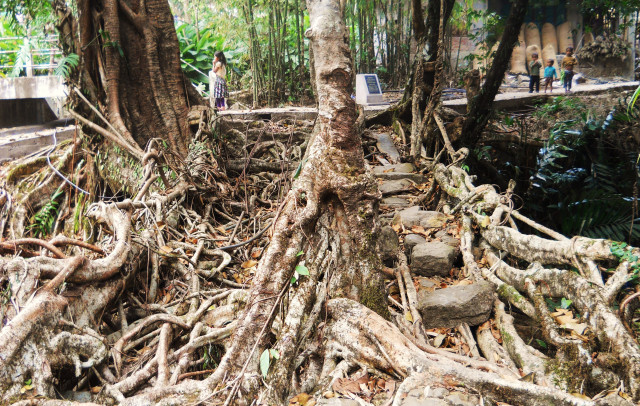
This living root bridge is especially interesting for several reasons. The first, and most obvious, is that it is a single root bridge composed of two parallel spans. What makes it more intriguing is that the span pictured to the left of the photo above was first planted much later than the span on the right and also exhibits significantly different growth patters.
The newer span of Burma 1 is said to only be in the vicinity of 40 years old (and that is only a very rough estimate). The person who first started to grow it is still alive, and tells me that his decision to create a second span on the bridge was spur of the moment. One day, he simply felt that the bridge would look nicer with a second walkway, and proceeded to start growing one. Interestingly, the people of Burma village never used any kind of scaffolding as a means of guiding the roots to the other side of the river. They simply pulled roots from the already established ficus elastica tree across, tied them to objects on the opposite bank and to each-other, and waited for them to grow.
The bridge is also worthy of note because it is in unusually good condition, with practically no latex-cutting scars. It has been bypassed by an adjacent concrete structure, which was built when the locals thought the botanical bridge might fail. Still, the root bridge is well, and regularly, maintained, and the local village administration has outlawed inflicting any damage to it.
(Note: Another parallel span bridge exists in the nearby village of Padu. I’ve visited it, though before I began this project.)
For more information, go to: BURMA 1
KONGTHONG 3
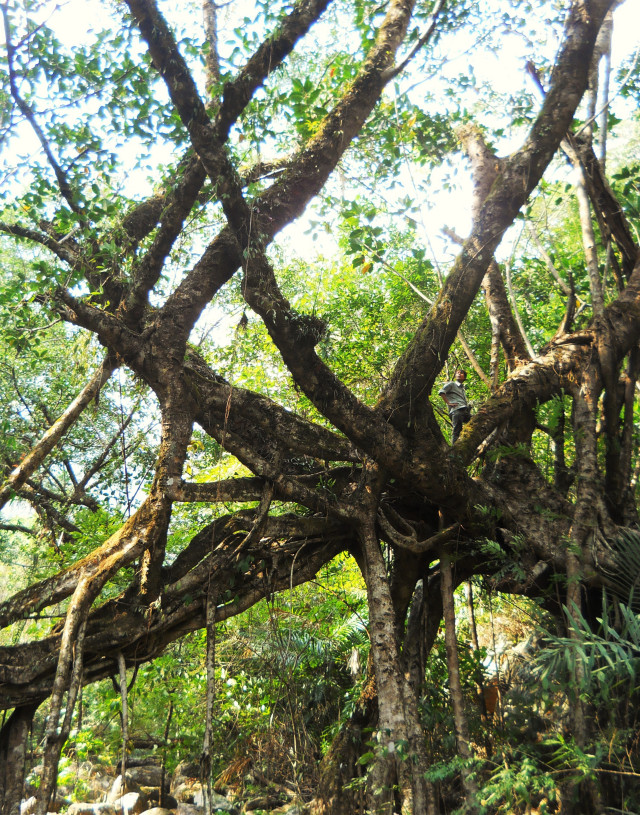
This is one of the most unusual root bridges I know of. The incline of the span is so steep that the “bridge” is almost a living root ramp. How the current arrangement of roots established itself is difficult to say.
This appears to be a genuine instance where the tree the root bridge is formed from is hundreds of years old. In places, roots which have clearly been guided to help form the bridge are several feet in diameter, meaning they have been in position for a very long time.
The bridge has several other interesting features, including one part of the steeply inclining span where large gouges have been cut into the roots in order to form steps, and another place where several roots have been trained sideways to create rungs, like those of a ladder. The way in which most of the fig tree has found itself propped up above the stream is also highly unusual, and may be another indicator of the organism being very old, the watercourse having shifted significantly since the tree first took root. Also, the bridge has a newer section (not in the photo above) where it looks as though roots were recently trained from the tree to the river bank, once more indicating that the shape of the river may have changed.
For more information, go to: KONGTHONG 3
KUDENG RIM 5
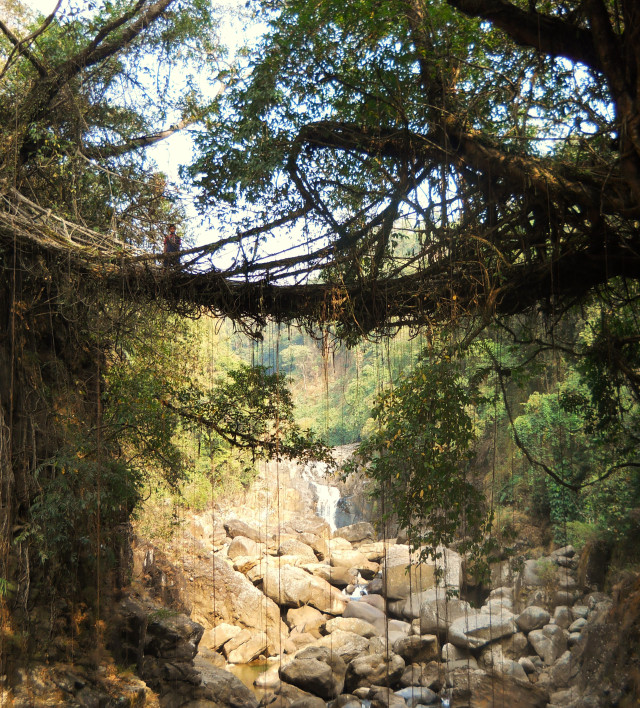
Kudeng Rim 5 is exceptional for the obvious reason that it is found in one of the most dramatic settings of any living root bridge. The structure is over 19 m above the river Amkshar, crosses a sheer-walled canyon, and, viewed from downstream, frames a large waterfall. The view is one of the very most impressive that I know of in Meghalaya.
The bridge is well above average both in terms of length and height. It has the 4th tallest measured height of any bridge thus far included in the project.
It is also, sadly, a piece of botanical architecture which seems unlikely to last much longer. Upon visiting in 2016, I observed that large parts of the tree were rotting, yet had not been a year earlier in 2015. The bridge seemed significantly more precarious on this later visit, and I observed that large parts of the structure seemed to have thinned out.
The possibility of this bridge disappearing soon makes documenting it and collecting as much information on it as soon as possible all the more vital.
For more information, go to: KUDENG RIM 5
MAWLAM 3
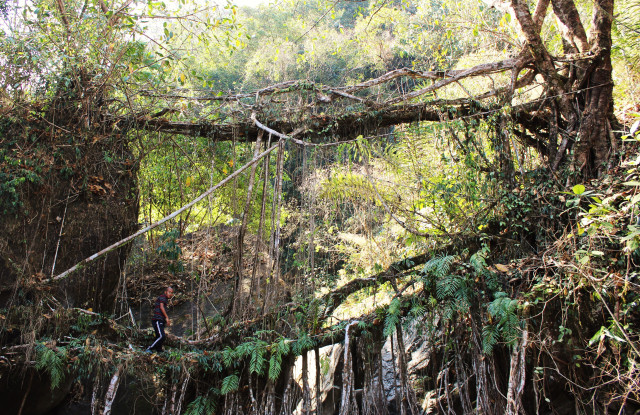
I’ve included Mawlam 3 on this list because it is an example of an extremely rare “Double Decker,” root bridge. The Nongriat double decker (go to: NONGRIAT 3) is often claimed to be the world’s only double span root bridge where the spans occur one above the other. However, Mawlam 3 exhibits almost exactly the same configuration.
I believe that this shows something important about the practice as a whole, which is that the designs of living root bridges are much more varied than one would know simply by visiting the more famous examples.
For more information, go to: MAWLAM 3
MAWSHUIT 1
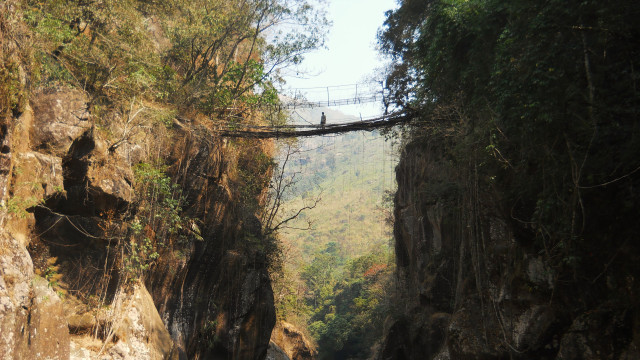
Mawshuit 1 is an extremely precarious, abandoned, and critically threatened root bridge that occurs above the main channel of the Myor river. It has several features which make it noteworthy, the first being its unusual (though still unmeasured) height. Also, the bridge is in one of the most dramatic settings of any living root bridge.
It is unfortunately situated in an area where botanical architecture seems to be fading out rapidly. On my most recent visit to the bridge, I found that much of the nearby jungle had been cleared in a shifting cultivation fire so recent that the ground was still smoldering. The structure could very easily be affected in the near future. The locals don’t have any direct incentive to maintain the bridge as it serviced a path which is no longer in use and has been bypassed by a recently constructed road. Also, even for the villagers, the unmaintained bridge is dangerous to cross.
Still, despite the danger, Mawshuit 1 is an impressive example of botanical architecture, and worth conserving.
For more information, go to: MAWSHUIT 1
NONGSTENG 1
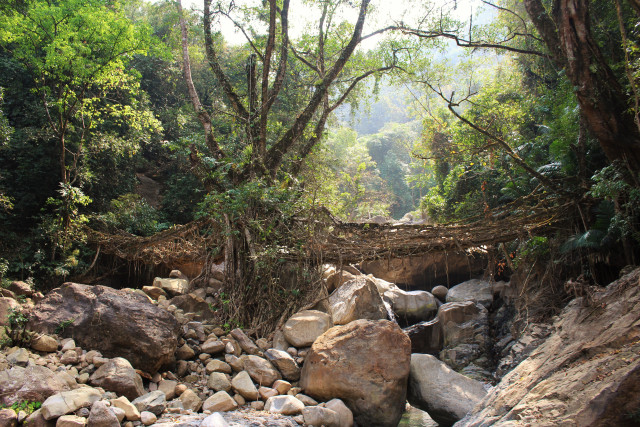
This very large root bridge consists of three separate spans, though a person crossing it remains suspended by the structure over a distance of 36 m, making it much longer than average.
The layout of the bridge is unusual. One of the trees which make up the structure was planted on a small island in the middle of the Rynseit river. Much of the bridge was then trained outward from this point.
Nongsteng 1 is the last (known) surviving living root bridge on the Rynseit. Several others existed in recent memory (see: NONGSTENG 2, NONGSTENG 3, NONGSTENG 4), but were destroyed due to changing conditions on the stream. This means that Nongsteng 1 is a rare example of a living root bridge which is both very old, but that has also withstood a great deal of abuse.
For more information, go to: NONGSTENG 1
RANGTHYLLIANG 4
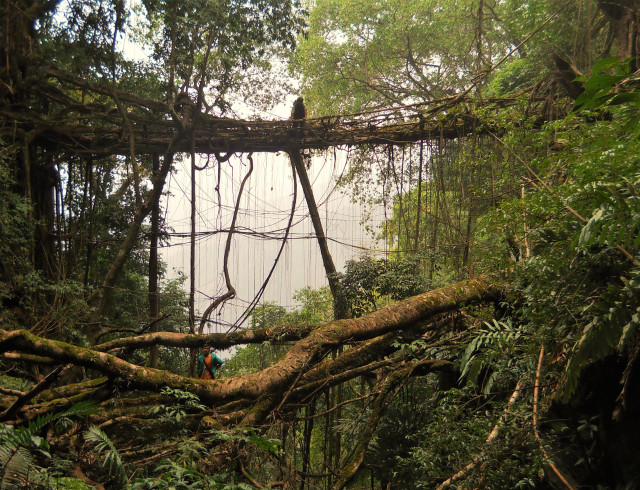
Rangthylliang 4 is exceptional for two entirely separate reasons. The first is that it was once the only known example of a triple span living root bridge. This was the case until at least around 2013. Sadly, the third span has now disappeared entirely (information is sketchy as to why this happened). Still, the bridge can continue to be classed as a “Double Decker,” even if recently a large trunk fell over the lower surviving span. That part of the bridge is no longer in use, though the roots are still strong. It may be possible for the lower span to be partially regenerated, as, while the tree it is formed from is damaged, it still seems to be alive.
The surviving, upper, span still appears stable and well maintained. At close to 24 m in height, this was the tallest living root bridge that I was able to measure.
For more information, go to: RANGTHYLLIANG 4
RANGTHYLLIANG 8
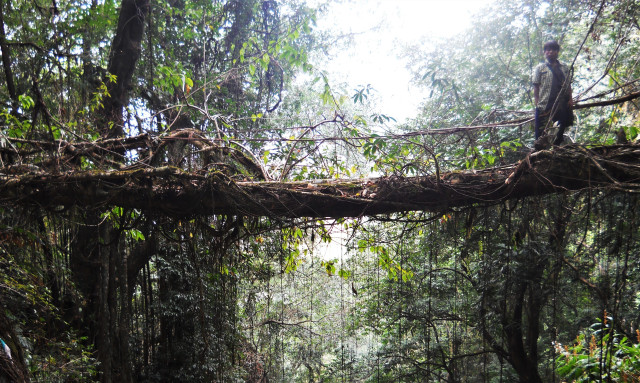
This double bridge has a configuration that I’ve never encountered anywhere else. It is formed from two spans which come together at a 90 degree angle. Additionally, the longer section of the bridge is the third highest measured span I visited as part of the project.
The bridge is in a very scenic setting, with a waterfall behind it and another plunging under the longer span. In crossing the longer span, you can look down from the bridge and onto the waterfall.
Sadly, the Pynursla River is badly polluted at this point. Upstream, the river flows through the Pynursla bazaar, and so a great deal of trash gets washed down. How much the trash effects the health of the bridge is hard to say, though it certainly lessens the bridge’s aesthetic appeal. Still, the singularity of the bridge’s layout, combined with its unusually scenic surroundings, make it more than worthy of preservation.
For more information, go to: RANGTHYLLIANG 8
RANGTHYLLIANG 12
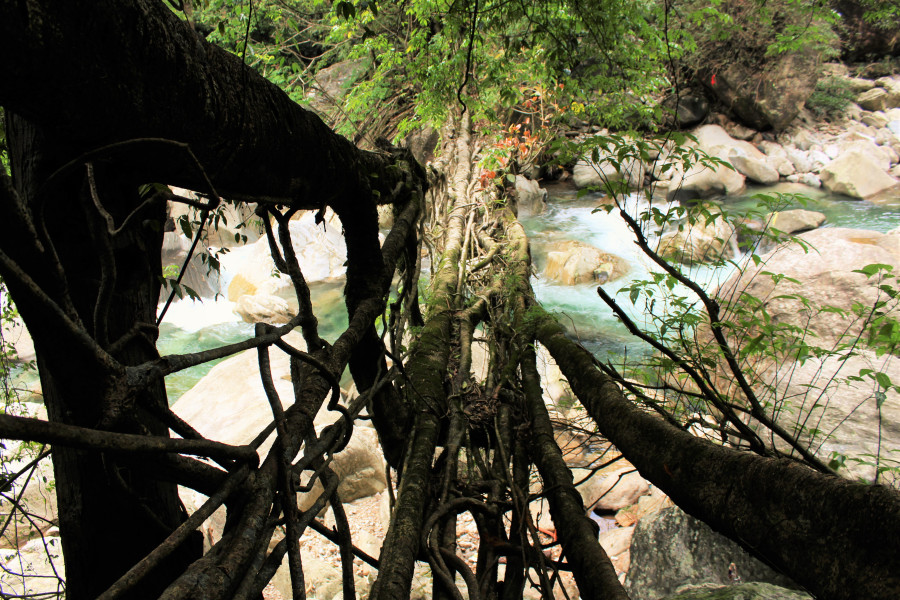
I view Ranghtylliang 12 as being one of the very most important individual living root bridges when it comes to to understanding the phenomenon of botanical architecture as a whole. At over 52 m (calculated conservatively), the bridge is the longest example I’ve been able to measure. However, not only is the bridge extremely long, its also very old. The roots it is formed from are exceedingly thick.
The structure is located over a large river, and must have withstood centuries of intense monsoonal floods. What this means is that Ranghtylliang 12 can be seen as an unusually “successful” living root bridge, and so examining and documenting it in detail could be critical when it comes to considering future practical applications for living architecture.
The tree the bridge is formed from is large. It seems to have been planted on an island in the middle of the Pynursla River, and then to have grown outwards from this point. The bridge also has an unusual living ramp structure on its eastern side.
Unfortunately, so far it’s proven difficult to find much information as to the bridge’s history. The paths it currently services do not seem to be very well traveled. The bridge also shows signs of sickness in some of its roots, though overall the structure seems very stable.
For more information, go to: RANGTHYLLIANG 12
THANGKYRTA 2
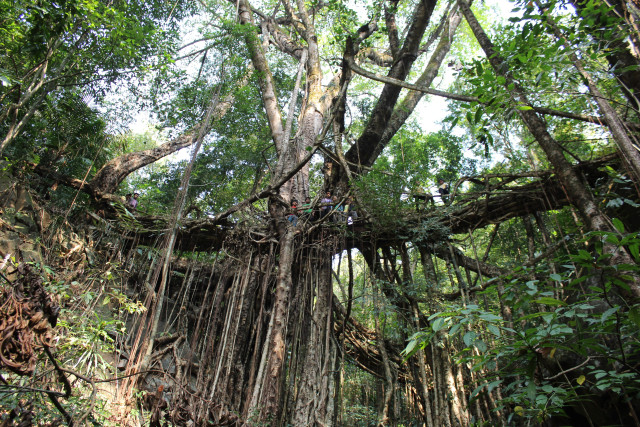
Thangkyrta 2 is perhaps the most unusual living root bridge I’ve encountered. It is noteworthy first and foremost because the tree it is formed from is truly vast. The bridge is said to have been first created by a village which no longer exists, and is thought to have divided into several settlements sometime before the turn of the 20th century, leaving the bridge behind.
In all of my time in Meghalaya, with the possible exceptions of Rangthylliang 12 and nearby Thankyrta 1, I have never come across a living root bridge made from a tree that was even remotely as large as the one Thangkyrta 2 is generated from. This may mean that Thankyrta 2 is much older than average, and for this reason alone it would be worthy of inclusion on this list.
But Thangkyrta 2 is also noteworthy for being a double bridge, with two roughly parallel spans. Only one is still in use, and services the current path between the villages of Mawtongreng and Thangkyrta, however the abandoned span still appears healthy. It is not known why the bridge required two spans.
While the bridge is clearly still very strong, the whole organism is covered with latex extraction scars, some of which were only days old when I visited. Additionally, the area Thangkyrta 2 is located in is subject to frequent shifting cultivation fires.
The structure is difficult to photograph in its entirety, and so the bridge does not lend itself to postcard shots. Still, as one of the most fascinating and unusual individual examples of botanical architecture known to exist, it is important that Thangkyrta 2 be preserved for later generations, and also documented thoroughly.
For more information, go to: THANGKYRTA 2